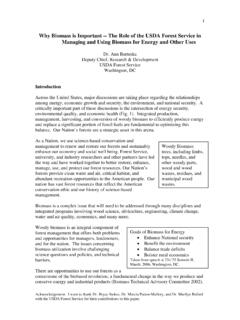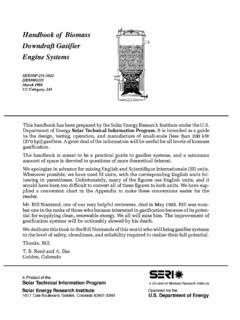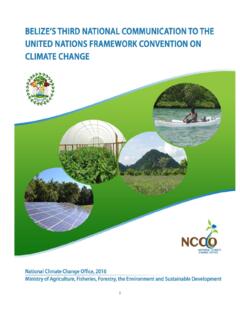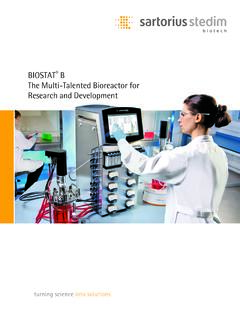Transcription of Sustainable Aviation Fuel - Energy
1 Sustainable Aviation Fuel Review of Technical Pathways (This page intentionally left blank) iii Acknowledgments This report was prepared by Johnathan Holladay (Pacific Northwest National Laboratory), Zia Abdullah (National Renewable Energy Laboratory), and Joshua Heyne (University of Dayton) and is a compilation of information synthesized from three workshops with additional new information inspired from the workshops. The authors are indebted to Michelle Kocal (LanzaTech), Steve Csonka (Commercial Aviation Alternative Fuels Initiative), Bill Goldner ( Department of Agriculture), Mark Rumizen (Federal Aviation Administration), Carol Sim (retired Alaska Airlines, Washington State University), and Jim Hileman (Federal Aviation Administration) for their poignant, challenging, and critical review of concepts in the report.
2 The authors also thank Zia Haq, Liz Moore ( Department of Energy , Bioenergy Technologies Office), and Mohan Gupta (Federal Aviation Administration) for support. iv Abstract The 106-billion-gallon global ( 21-billion-gallon domestic) commercial jet fuel market is projected to grow to over 230 billion gallons by 2050 ( EIA 2020a). Cost-competitive, environmentally Sustainable Aviation fuels (SAFs) are recognized as a critical part of decoupling carbon growth from market growth. Renewable and wasted carbon can provide a path to low-cost, clean-burning, and low-soot-producing jet fuel. research shows an opportunity to produce fuel in which aromatics are initially diluted with the addition of renewable iso-alkanes, aromatics are later fully replaced with cycloalkanes, and finally high-performance molecules that provide mission-based value to jet fuel consumers are introduced.
3 Key to this fuel pathway is sourcing the three SAF blendstocks iso-alkanes, cycloalkanes, and high-performing molecules from inexpensive resources. When resourced from waste carbon, there are often additional benefits, such as cleaner water when sourcing carbon from wet sludges or less waste going to landfills when sourcing the carbon from municipal solid waste or plastic waste. Jet fuel properties differ from gasoline and diesel, so research will be most successful if it begins with the end result in mind. Sustainable Aviation Fuel: Review of Technical Pathways v List of Acronyms ASTM ASTM International ATJ alcohol-to-jet BETO Bioenergy Technologies Office Btu British thermal unit(s) CAAFI Commercial Aviation Alternative Fuels Initiative Co-Optima Co-Optimization of Fuels & Engines CORSIA Carbon Offsetting and Reduction Scheme for International Aviation DCN derived cetane number DOE Department of Energy EERE Office of Energy Efficiency and Renewable Energy FAA Federal Aviation Administration FT Fischer-Tropsch GHG greenhouse gas HEFA hydroprocessed esters and fatty acids HTL hydrothermal liquefaction ICAO International Civil Aviation Organization LCA life-cycle analysis MFSP minimum fuel selling price MSW municipal solid waste NASA National Aeronautics and Space Administration NJFCP National Jet Fuels Combustion Program NREL National Renewable Energy Laboratory OEM original equipment manufacturer PNNL
4 Pacific Northwest National Laboratory R&D research and development SAF Sustainable Aviation fuel SPK synthetic paraffinic kerosene syngas synthesis gas TEA techno-economic analysis USDA Department of Agriculture Sustainable Aviation Fuel: Review of Technical Pathways vi Executive Summary Airlines have committed to carbon-neutral growth in international commercial Aviation beginning in 2021 and airlines have set a goal to reduce carbon dioxide (CO2) emissions by 50% in 2050 compared to 2005 levels (Airlines for America 2020; I ATA 2020). airlines have improved efficiency by 130% compared to 1978 levels (Airlines for America 2020). Additional efficiency improvements in planes and engines are not likely to be enough. Meeting the 2050 goal will required fuels that have a lower carbon footprint, referred to as Sustainable Aviation fuel (SAF) defined by the International Civil Aviation Organization (ICAO) as alternative Aviation fuels that (i) achieve net GHG [greenhouse gas] emissions reduction on a life cycle basis; (ii) respect the areas of high importance for biodiversity, conservation and benefits for people from ecosystems, in accordance with international and national regulations; and (iii) contribute to local social and economic development , and competition with food and water should be avoided (ICAO 2018).
5 One challenge for providing SAF is that the size of the jet fuel market is large and growing. Global demand is expected to increase from 106 billion gallons in 2019 to 230 billion gallons in 2050 ( EIA 2020a). The domestic market in 2019 was 26 billion gallons, exceeding 3 quadrillion British thermal units (3 quads) ( EIA 2019). This market could consume several hundred million tons of biomass per year, which is consistent with the current availability of biomass in the United States ( 340 million tons) (Langholtz, Stokes, and Eaton 2016). A second challenge is that the price of SAF today is higher than petroleum-based Jet A fuel. Fuel price is a hurdle because fuel is 20% 30% of the operating cost of an airline (IATA 2018). research and development (R&D) can help bring the cost down.
6 Unlike light-duty vehicles, the low Energy density of even the best batteries severely limits opportunities for While many are working on electrification, efforts are for smaller aircraft and airlines will have no alternative for some time but to use SAF to operate in a GHG-emission-constrained future. Part I of this report provides an overview of commercial jet Aviation fuel: how it compares to fuels for cars and trucks, its composition, its specification, and its certification process. Jet fuels consist of n-alkanes, iso-alkanes, cycloalkanes, and aromatics. Aromatics do not burn as cleanly as alkanes, resulting in higher particulate emissions, and have lower specific Energy . The n- alkanes are acceptable but do not meet fluidity and handling properties, limiting their blend potential.
7 The iso-alkanes have high specific Energy , good thermal stability, and low freezing points. Cycloalkanes bring complementary value to iso-alkanes, providing the same functional benefits as aromatics by enabling fuels to meet the density requirement and potentially providing the seal-swelling capacity provided today from aromatics. Combined, iso-alkanes and cycloalkanes offer the potential to add value to a fuel by enabling high specific Energy and Energy density and minimizing emission characteristics. The Department of Energy (DOE) is evaluating the hypothesis that improved fuel energetic properties ( , specific Energy and Energy density) may provide increased range, higher payload capacity, or fuel savings. Original equipment manufacturer (OEM)-led ASTM D4054 fit-for-purpose testing generally costs several million dollars and can require years to be approved (ASTM 2018).
8 A fast-track approval process has been accepted for fuels in which the SAF blending component is limited to 10% and consists of the same types of molecules that are in petroleum-based jet fuel. A clearinghouse annex has also been proposed to reduce cost and time for approval. The Bioenergy Technologies Office (BETO), Federal Aviation Administration, and Department of Defense are investing in prescreening and testing protocols that need only small quantities (milliliters to liters) to provide feedback about a candidate fuel blend fit-for-purpose. To date, t here are six 1 Jet fuel has an Energy density equal to 43 MJ/kg, while lithium-ion batteries in today s electric vehicles have an Energy density equal to MJ/kg (200 Wh/kg). The amount of weight severely limits battery use in large passenger aircraft.
9 Sustainable Aviation Fuel: Review of Technical Pathways vii ASTM International (ASTM) D7566-approved SAFs for use in up to 10% to 50% blends. The SAF initially composed of n- and iso-alkanes now include all four hydrocarbon families listed previously and are produced from synthesis gas (syngas); fats, oils, and greases; sugars; and alcohols. Part I finishes by summarizing the learnings from three BETO-supported workshops. These include the Alternative Aviation Fuel Workshop held in Macon, Georgia, in 2016, which focused on SAF production; the JET workshop held in Cleveland, Ohio, in 2017, which focused on high-performance fuels; and the Trilateral Biojet Workshop held in Richland, Washington, in 2018, which focused on jet fuel R&D collaborations between Canada, the United States, and Mexico.
10 Some of the key learnings from these workshops include: The Aviation industry seeks to reduce its GHG emissions significantly, decoupling airline growth from carbon growth. The current cost of SAF is high. Airlines are willing to support SAF development by purchasing some fuel at a higher price, but for SAF to scale, prices need to be reduced. OEM-led ASTM D4054 approval and evaluation process is expensive and time-consuming. Developing new engines is even more onerous regarding timescale and cost, and hence a program coupling fuel development and engine development R&D would not help overcome industry barriers. Existing engines can use fuels that have a much higher heat of combustion than Jet A, and specific Energy ( , heat of combustion) increases can deliver greater range, higher payload capacity, or decreased fuel consumption.


















